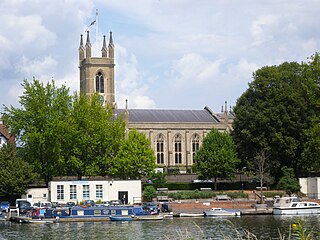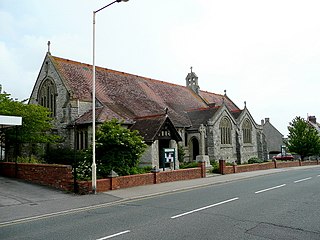
Sir Arthur William Blomfield was an English architect. He became president of the Architectural Association in 1861; a Fellow of the Royal Institute of British Architects in 1867 and vice-president of the RIBA in 1886. He was educated at Trinity College, Cambridge, where he studied Architecture.

George Halford Fellowes Prynne (1853–1927) was a Victorian and Edwardian English church architect. Part of the High Church school of Gothic Revival Architecture, Prynne's work can be found across Southern England.

St John the Divine, Kennington, is an Anglican church in London. The parish of Kennington is within the Anglican Diocese of Southwark. The church was designed by the architect George Edmund Street in the Decorated Gothic style, and was built between 1871 and 1874. Today it is a grade I listed building.

The St Saviour's Cathedral is the heritage-listed cathedral church of the Anglican Diocese of Canberra and Goulburn in Goulburn, Goulburn Mulwaree Council, New South Wales, Australia. The cathedral is dedicated to Jesus, in his title of Saviour. The current dean is the Very Reverend Gavin Krebs. It was added to the New South Wales State Heritage Register on 20 April 2009.

The Church of St Mary the Virgin is in Leek Road, Bosley, Cheshire, England. It is recorded in the National Heritage List for England as a designated Grade II* listed building. It is an active Anglican parish church in the diocese of Chester, the archdeaconry of Macclesfield, and the deanery of Macclesfield. Its benefice is combined with those of St Michael, North Rode, St Michael, Wincle, and St Saviour, Wildboarclough.

All Saints' Church is a Church of England parish church in West Dulwich, South London. It is a red brick building designed in a Gothic Revival style by George Fellowes Prynne and built 1888–91. It is Grade I listed.

St Margaret's Church is an Anglican church in the Ifield neighbourhood of Crawley, a town and borough in West Sussex, England. It is the ancient parish church of the village of Ifield; the medieval settlement was expanded to form one of the New Town of Crawley's 13 neighbourhoods, and the church's modern parish now serves several other neighbourhoods as well.

St Saviour's is an Anglo-Catholic church in Pimlico, City of Westminster, London, England, located at the north end of St George's Square. It was constructed in the 1860s as part of Thomas Cubitt's development of the area on behalf of the Marquess of Westminster. The church was designed by Thomas Cundy, who had previously built St Gabriel's Pimlico a short distance away. As with St Gabriel's, St Saviour's was designed in the Gothic style and built in ragstone to emphasise the contrast with the classical stucco of its secular neighbours. The church is Grade II listed.

St Mary's Parish Church, Hampton, is an Anglican church in Hampton in the London Borough of Richmond upon Thames.

St. Paul's Episcopal Cathedral, is located in downtown Des Moines, Iowa, United States. It is the cathedral church of the Episcopal Diocese of Iowa. The building was listed on the National Register of Historic Places as St. Paul's Episcopal Church.

St Mark's Church is an Anglican church in the village of Hadlow Down in the district of Wealden, one of six local government districts in the English county of East Sussex. Founded in 1834 by a committed local resident who petitioned the Archbishop of Canterbury for permission to establish a chapel in the poor agricultural village, the church proved popular—despite the competing presence of two Nonconformist chapels nearby—and was extended in 1913. The stone-built church, with its tall spire and well-regarded "living churchyard" nature reserve, is now Hadlow Down's only remaining place of worship. English Heritage has listed it at Grade II for its architectural and historical importance.

James Brooks (1825–1901) was an influential English Gothic Revival architect and designer. Brooks established his reputation through a series of landmark churches built in the East End of London in the 1860 and 1870s, and was awarded the Royal Institute of British Architects' Royal Gold Medal in 1895.

Christ Church Cathedral is a heritage-listed Anglican cathedral complex at Duke Street, Grafton, Clarence Valley Council, New South Wales, Australia. The cathedral was designed by John Horbury Hunt and built from 1874 to 1884 by Reynold Brothers (brickwork) and G. J. T. Lawson (woodwork). It is also known as Cathedral Church of Christ the King and Grafton Anglican Cathedral. The property is owned by the Anglican Diocese of Grafton. It was added to the New South Wales State Heritage Register on 14 March 2003.
St Peter's Church, Ealing, is an Anglican parish church in Mount Park Road, North Ealing, in the Diocese of London, regarded by Sir John Betjeman as an example of a Victorian-built church "of which we can be proud". Held to be one of the premier architectural works in Ealing, the Grade II* Listed building is noted for its combination of Arts & Crafts and late-Victorian Gothic as well as its west front and great west window. In addition to Sunday and weekday services, the church and adjacent hall serve as a hub for various community activities and events.

Holy Trinity Church, St Austell is a Grade I listed parish church in the Church of England in St Austell, Cornwall.

St Ladoca's Church, Ladock, is a Grade I listed parish church in the Church of England Diocese of Truro in Ladock, Cornwall, England, UK.

St Mary's Church, Ilford or St Mary's Church, Great Ilford is a Church of England parish church in Ilford, located in the London Borough of Redbridge.

St Paul's Church is a Church of England parish church in Westham, Weymouth, Dorset, England. Designed by George Fellowes Prynne, the bulk of the church was built in 1894–96. It has been a Grade II listed building since 1974, with the World War I memorial outside also designated Grade II in 2016. In their book The Buildings of England: Dorset, John Newman and Nikolaus Pevsner noted the church's "idiosyncratic but convincing design".

Edward Arthur Fellowes Prynne (1854–1921) was a leading British late Pre-Raphaelite painter of portraits and subject pictures, who in later life became one of the country's best-known creators of decorative art for churches.

St Mary the Virgin Church is a partly medieval Grade II* listed flint church on Church Road in Hayes, Hillingdon. The central portion of the church, the chancel and the nave, was built in the 13th century, the north aisle in the 15th century, and the south aisle in the 16th century, along with the lychgate and the south porch.




















